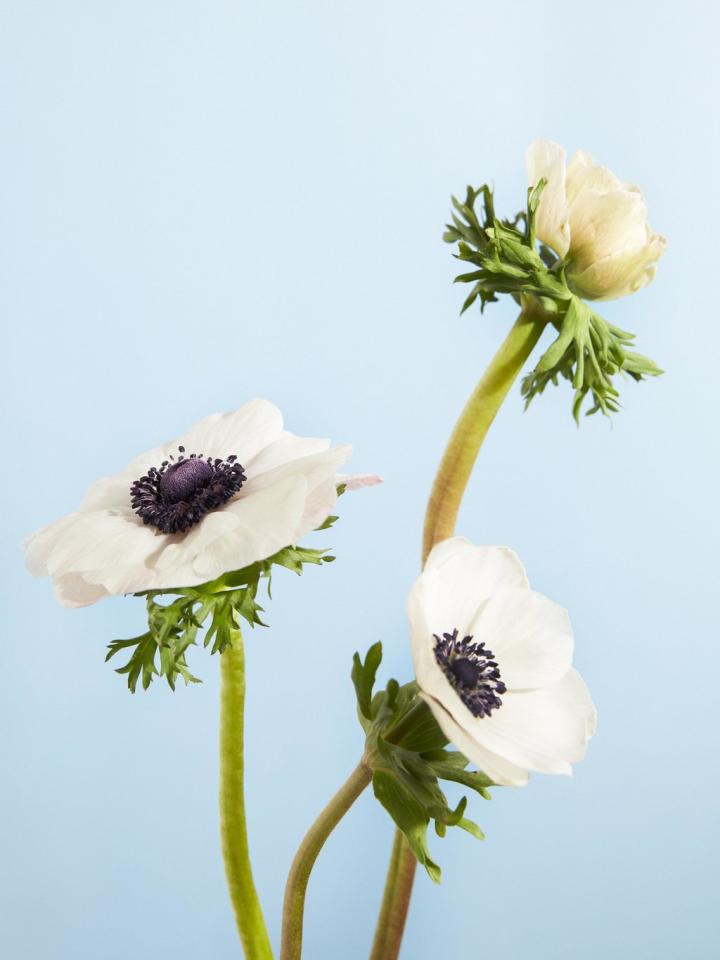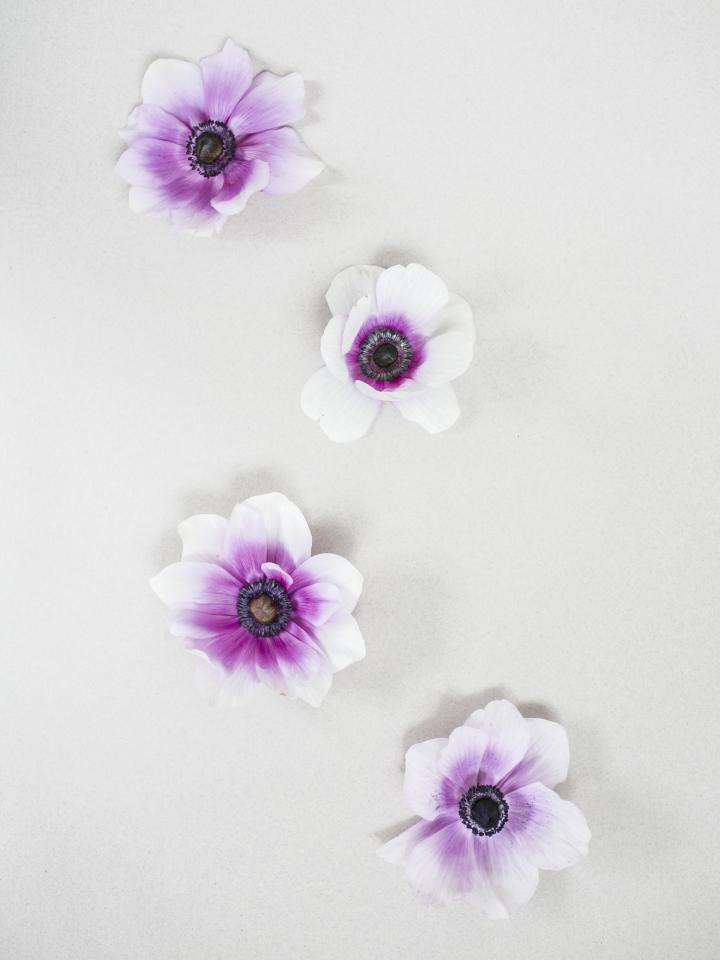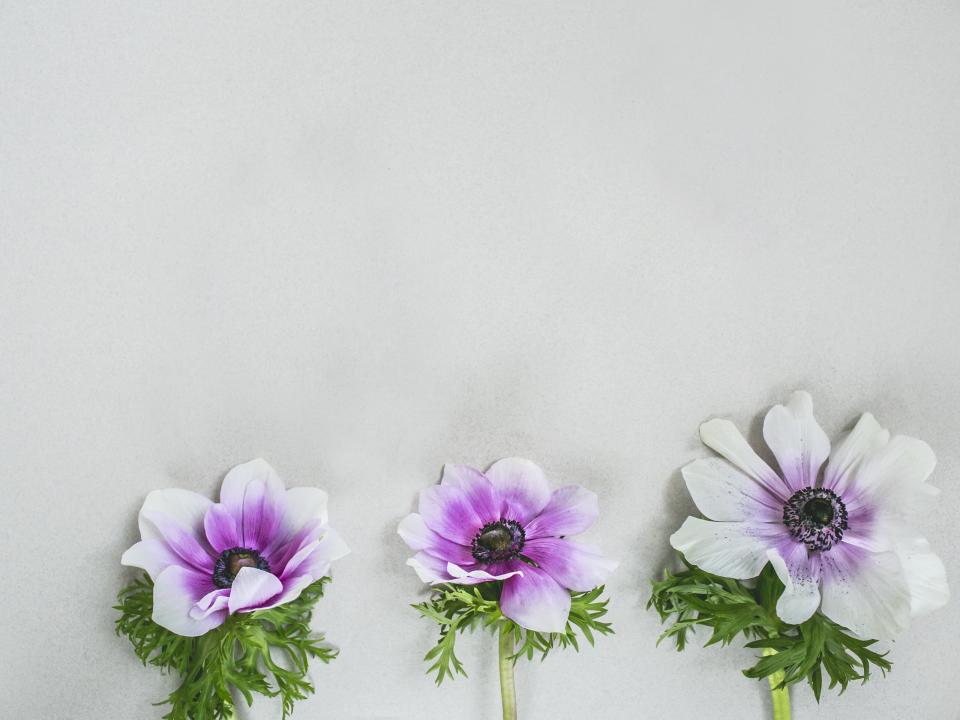Anemone: characteristics and flowering
The heart of Anemone is theatrically black, golden yellow or green. This heart is surrounded by white, lilac, pink, red or purple petals. The combination of a beautiful bright centre in a large flower makes anemone irresistible. Bees, bumblebees and insects love this plant, making it a great biodiverse pick. The flowering season of anemones is between March and October, depending on the variety. There are spring-flowering and autumn-flowering anemones.
The spring bloomers flower in March-April, usually stay lower to the ground and are mainly white in colour. Autumn anemones flower from July/August until frost sets in. These anemones can be various colours, such as white, pink, blue and purple. The number of petals and height also vary between the two seasonal varieties. Some anemones have a single row of petals, while others have more.
Anemone belongs to the ranunculaceae family, which also includes plants such as ranunculus and buttercup. The plant usually grows between 10-100 cm high and has an unusual structure with lots of green leaves at the bottom with a narrow stem
Anemone species
The anemone genus contains more than 120 species. A distinction is often made between wood anemones (low-growing spring anemones, perfect for ground cover), spring anemones (anemones that flower around March and April) and autumn anemones (anemones that flower from July until the first frost). In addition, the anemone can be classified according to the main species listed below, which in turn include many varieties:
- Anemone coronaria: this is also called the ‘common anemone’ or ‘crown anemone’. The species is known for its striking flowers in deep colours such as red, blue, purple and white. The centre of this species is usually dark brown to black. Anemone coronaria flowers between May and October, prefers full sun and grows around 30-50 centimetres tall. The leaves of this species resemble those of a fern.
- Anemone nemorosa: this is a spring-flowering wood anemone with fine, fern-like leaves. This anemone prefers shade and usually has white flowers with a yellow centre. This low-growing species grows about 15-30 centimetres high.
- Anemone hupehensis: this is an autumn anemone with pale pink, white or purple flowers that bloom between July and September. The flowers usually have a yellowish to light green flower heart. This plant grows about 60-90 centimetres tall.
- Anemone blanda: this low-growing species (10-15 centimetres high) is also called Oriental anemone. It is a spring bloomer with relatively large flowers. The flower can be blue, pink, white or purple in colour and have a yellow-green to light green centre. This species prefers semi-shade.
- Anemone sylvestris: this spring-flowering anemone resembles the wood anemone (Anemone nemorosa), but has larger white flowers that, like the wood anemone, have a yellow heart. This species grows about 30 centimetres high, has a relatively long flowering period and prefers full sun to semi-shade.
- Anemone ranunculoides: this wood anemone has bright yellow flowers with a yellow heart. This low-growing species (10-20 centimetres high) flowers in early spring and thrives best in a spot in semi-shade or shade.
- Anemone x hybrida: hybrid anemones, also called Japanese anemones, have large flowers in white, pink or light purple. Hybrid anemones are autumn anemones, meaning they flower in late summer and autumn. This variety thrives best in a spot in semi-shade or shade and usually grows the tallest of all anemones, around 30-100 or even 120 centimetres tall. This makes it ideal as a rear plant in borders.

How to care for anemone as a cut flower in your vase
As a single stem or in a bouquet, the anemone always shines. One thing is for sure - you want to enjoy your anemones for as long as possible. Check out these tips and tricks to keep flowers looking beautiful in your vase and see our the care tips for anemones below:
- Cut the flower stem of the anemone at an angle with a sharp, clean knife.
- Place the anemone in a small layer of water in a clean vase.
- Add cut flower food for longer flower life.
- Top up the vase water regularly, as anemones are thirsty plants.
- Don't place the anemone in full sun, in a draught or next to a fruit bowl.
How and when do you plant anemones in a garden?
There are two ways to approach planting anemones. You can either plant them as bulbs or as young plants. See more information and step-by-step plans on planting garden plants here and check out our tips below:
- Anemone bulbs can be planted in special seed trays, in pots or in the garden. It's best to plant the bulbs in spring or autumn (when the chance of hard frost has passed) and as soon as possible after purchasing them.
- The best time to plant bulbs depends on the flowering time of each anemone. For spring flowering, you can plant the tubers in autumn. For flowering in summer and autumn, plant the tubers in early spring (after the chance of hard frost has passed) in the open ground.
- Before planting the bulbs, soak them in lukewarm water overnight. This softens the bulbs and makes them root easier and faster.
- Keep a planting distance of about 10 centimetres and a depth of about 7 centimetres for the bulbs in the open ground.
- If you buy an anemone as a potted plant, make sure the potting soil has good drainage holes so excess water can drain out. Add a small layer of pottery shards, shells or hydro pellets for better moisture control.
How to care for anemoneplants
If you're looking to plant anemones outside, check out the tips below for the best location and caretaking tips for anemones in your garden or on your balcony:
- Spring anemones like plenty of light and sufficient moisture. After flowering, they're more flexible about being in the shade or having dry soil.
- Autumn anemones tend to be hardier than spring anemones. They like a spot in full sun or semi-shade.
- Autumn anemones that grow taller (about 1-1.5m) like to be in a sheltered spot, out of the wind.
- Anemone likes rich, loose, moist soil.
- Use organic fertiliser in spring, especially for bulbs.
- Anemone doesn't tolerate drought well. Give the flowers plenty of water during hot and dry periods. You can also place a layer of organic compost around the plants to help them retain moisture.
- Spring-flowering anemones tend to stay lower to the ground than autumn anemones. This makes spring-flowering anemones perfect for planting in a pot or container.
- If you deadhead spent flowers, you will help anemone to produce new buds and encourage a second round of flowering.
- Anemones are not evergreen (they die off above ground in winter), but are usually hardy (and can withstand frost). There are species that are less frost-resistant, such as Anemone coronaria. Cover these species with leaves or straw in winter to protect them from the cold. In the case of very severe frost, it is better to dig the bulbs out and let them overwinter in a frost-free spot such as a garage.
- Anemone is not very susceptible to pests and diseases, but scale insects or rust (fungus) can occur. Use organic pesticides to combat these.
- Autumn anemones are not susceptible to snail infestations, as snails do not like their rough leaves and slightly hairy stems.
How and when should you prune anemones?
When it comes to pruning, anemone are low maintenance. You can cut off the old, dead flowers immediately after flowering to just above the ground. By removing spent flowers, the plant puts all its energy into the bulb instead of the spent flowers, and you will have beautiful flowers again the following year. In early spring (after the chance of a hard frost has passed), you can prune the plant back completely and remove old, dead leaves so that the plant sprouts up nicely once more.
Anemones and winter
Anemone bulbs can generally be left in the ground over winter. Without a hard winter, they're likely to flower again the following year. Are you expecting a period of severe frost? To prevent the bulbs from freezing in the open ground, you can use old leaves or straw to cover the base of the plants. Is your anemone in a pot? If so, place the plant under a canopy, in a shed or protect the pot with bubble wrap during a period of severe cold.
How and when should you take anemone cuttings?
Want to propagate anemones, or cuttings? Anemones are best propagated by root cutting in late autumn or partial cutting in spring. Read all about taking plant cuttings here and discover step-by-step plans for different methods.
Is anemone poisonous?
Yes, anemone leaves and sap is toxic to humans and animals. The plant is poisonous both when ingested and when in contact with skin. Symptoms of poisoning range from intestinal and abdominal complaints to a burning sensation in the mouth and throat. In case of ingestion or other contact, get in touch with a vet or doctor immediately.

Where does the name anemone come from?
The name ‘anemone’ probably comes from the Greek word ‘anemos’, meaning ‘wind’. This explains why the anemone is also called the wind flower, with its petals move with the rhythm of the wind.
Another story about the origin of the name is an ancient Roman folk tale. Zephyros, the god of the west wind, is said to have fallen in love with Anemona, a nymph. Anemona was turned into a flower by the jealous goddess Flora so that Zephyros could only kiss her petals.
Anemone symbolism
Anemone can be seen as a symbol of a new wind blowing through one's life. Therefore, anemones symbolises hope and a new beginning. In addition, the ‘moving along’ anemone is seen as a symbol of caring, devotion, affection and love. The anemone is often used in bouquets and floral arrangements to express love and appreciation.
Origins of the anemone
Anemones are native in many different places globally such as southern Europe, North America and central Asia. They thrive in different spots, such as forests, meadows and mountainous areas. In Europe, the flower has been known for centuries. The earliest mentions date back to ancient times. Anemones gained popularity over the centuries because of their attractive flowers and easy growing conditions. In the 17th and 18th centuries, anemones were increasingly planted in European gardens. Today, anemones are popular worldwide as cut flowers and garden plants. We frequently see the flower in bouquets, flower arrangements, borders, plant pots and as ground cover.







